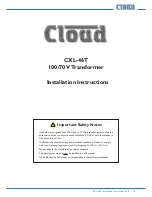
S&C Instruction Sheet 1072-530
55
The
Shell
tab, shown in Figure 82 on page 54, is provided to support advanced integrator
troubleshooting and is not used for configuration of a SpeedNet Radio network. A limited
selection of LINUX shell commands (e.g. cat, cd, ls) can be executed. Execution of shell
commands is performed in a batch manner, waiting for the output to complete before
returning a result. As such, execution of commands that produce continuing output (e.g.
default LINUX ping command) will “hang” the shell command in the client tool without
ever returning a result.
Here are some useful shell commands and their descriptions. Note that shell commands
are for advanced users, and they are not guaranteed to carry forward into future versions
of SpeedNet Radio firmware. These shell commands lack the automated range and other
check features of the SpeedNet Client Tool GUI.
NOTE:
Shell commands have the potential to lock up radios in a state that requires
power cycling or (worse) a state that prevents them from rebooting successfully. Because
of this, shell commands should be used with caution.
• cat /etc/config/config.dat—
Prints the configuration file; users can copy and paste
the result into another tool (e.g. Windows Notepad) to create a record of radio
configurations
• cat /proc/aodv/neighbor—
Prints the AODV neighbor list; users can copy and paste the
result into another tool (e.g. Windows Notepad) to create a record of radio neighbors
that can greatly aid in determining the connectivity in the SpeedNet mesh
• head -n <count> /etc/config/config.dat—
Views the first few <count> lines of the
configuration file
• tail -n <count> /etc/config/config.dat—
Views the last <count> lines of the configu-
ration file
• ping -c <count> <host IP>—
Pings the host indicated by <host IP>; the number of
ping requests sent is controlled by <count>, and the SpeedNet Radio does not use DNS,
so <host IP> must be a standard dotted-number notation IP address (e.g., 192.168.200.1)
It is important that a value for <count> actually be set. Until the ping command has
completed execution (approximately <count> seconds) the radio will not respond to
further SNMP requests. If <count> is not set (i.e., if the -c option is not provided), the
ping command will not return and the radio will not answer SNMP requests until it is
rebooted. Because the radio cannot answer SNMP requests (such as reboot requests),
the only way to reboot will be to cycle power physically at the radio. Power cycling
radios installed in the field is a significant effort
• /sbin/route | grep <host IP>—
Print the route to <host IP>, if it exists. If this com-
mand returns nothing, it means no route to the indicated host exists. The line between
“route” and “grep” is a vertical bar and on most keyboards is generated by holding the
Shift key and pressing the backslash key
SpeedNet Client Tool








































